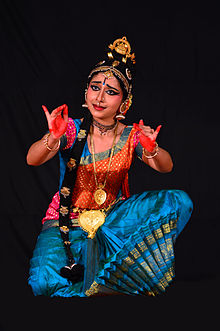Kuchipudi
[4][5][6] It developed as a religious art linked to traveling bards, temples and spiritual beliefs, like all major classical dances of India.
A dancer in a male role would be in Agnivastra, also known as Bagalbandi, wear a dhoti (a single pleated piece of cloth hanging down from the waist).
[26] Like other classical dance forms in India, Kuchipudi traces its roots to the Sanskrit Natya Shastra, a foundational treatise on the performing arts.
[27][31] Dance and performance arts, states this ancient text,[32] are a form of expression of spiritual ideas, virtues, and the essence of scriptures.
[39] To implant bhakti among layman he is credited with organizing Bhagavata Melas throughout the nights and adapting many dance forms from the Srimad Bhagavatha Puranas.
[41] According to Manohar Varadpande, the Kuchipudi dance emerged in the late 13th century, when Ganga rulers from Kalinga were patrons of performance arts based on the 12th-century Sanskrit scholar Jayadeva, particularly the Gita Govinda.
[4] This royal sponsorship, states Varadpande, encouraged many poets and dance-drama troupes to adopt Radha-Krishna themes into the then prevailing versions of classical Kuchipudi.
[43][42][44][note 1] Tirtha Narayanayati authored Sri Krishna Leela Tarangini and introduced sequences of rhythmic dance syllables at the end of the cantos, he wrote this work as a libretto for a dance-drama.
[43][46] So he went to Kuchelapuram, the village of his wife's family and present-day Kuchipudi, where he enlisted a group of young Brahmin boys to perform the play.
[52] With the fall of Vijayanagara Empire and the destruction of temples and Deccan cities by the Muslim army around 1565, musicians and dance-drama artists migrated south, and Tanjore kingdom records suggest some 500 such Kuchipudi artist families arrived from Andhra, were welcomed and granted land by the Hindu king Achyutappa Nayak, a settlement that grew to become modern Melattur near Tanjore (also called Thanjavur).
[54][55] After the death of Aurangzeb in 1707, the Mughal Empire collapsed, Hindu rebellion sprouted in many parts of India, including the Deccan region.
[56] In the second half of the 18th century, during this period of political turmoil, the colonial Europeans arrived, the Madras Presidency was formed by the East India Company officials and became a part of the British Empire.
Christian missionaries and British officials stereotyped and denigrated dancers, calling Indian classical dances as evidence of a tradition of "harlots, debased erotic culture, slavery to idols and priests".
[58][59][60] The anti-dance camp accused the various classical Indian dance forms as a front for prostitution, while revivalists questioned the constructed histories by the colonial writers.
[64] Vedantam Lakshminarayana Sastri (1886–1956) was the influential figure who led the effort to save, reconstruct and revive Kuchipudi performance art.
[70] The latter half of the twentieth century was dominated by the Kuchipudi school of Vempati Chinna Satyam, whose efforts to further codify the modern repertoire earned him multiple accolades, including the Padma Bhushan.
[75][14] The expressive style is through a sign language that follows the classical pan-Indian Sanskrit texts such as Natya Shastra, Abhinaya Darpana and Nrityararnavali.
[7][77] Just like the Carnatic music style, Kuchipudi shares many postures and expressive gestures with Bharatanatyam, such as the Ardhamandali or Aramadi"(half seating position or a partial squat, legs bent or knees flexed out).
[15] The repertoire of Kuchipudi, like all major classical Indian dance forms, follows the three categories of performance in the ancient Hindu text Natya Shastra.
[76][81] A complete Kuchipudi show sequence always consists of nritta and nritya in solo or group performance, but when the underlying text is a play, it may include a natya.
The actors present a pure dance (jatis or jatiswarams), performed rhythmically to a musical raga, and these are called Sollakath or Patakshara.
[90] Each basic unit combines hand and foot movement into a harmonious sthana (posture) and chari (gait), that visually appeals to the audience wherever he or may be sitting.
[92] The actor-dancer uses hand mudras and facial expressions inspired by the sign language in ancient Sanskrit texts, with an exacting footwork, to communicate the underlying story to the audience.
For example, the dancer may perform the footwork, rhythmically to music, while balancing a series of pots on his or her head, and then add burning Diya (lamp) in both hands, as the show goes on.
[95] Some artists dip their foot on a wet ink pad, then dance rhythmically on a blank white piece of paper, thus painting it; alternatively, the troupe places coloured rice powder on floor and on top the white piece of paper, then dances the musical composition on it, their weight and steps causing the pigment to stick.
Women artists wear a brilliantly colourful Sari (or a body fitting dress) with a pleated fan stitched in front to help highlight the exacting footwork.
[15] The forehead has a round red bindi or a symmetric tillaka, while the eyes are typically ringed with black collyrium to ease the viewing of expressions by the audience.
[75] Some special Kuchipudi plays may include unusual costumes and theatrics, such as round bottom water pot balanced on the head, dancing with gymnastics or stilt athletics.
[98] This openness and flexibility has been a historic tradition in Indian dance culture, and is traceable to early times in Kuchipudi as the Margi and Desi styles in the text Nrittaratnavali of Jaya Senapati.
[107] Traditional compositions that have been internationally performed by Kuchipudi artists, particularly among Telugu diaspora communities, include Srinivasa Kalyanam, Rukmini Kalyanam (marriage of Krishna and Rukmini), Sakuntalam Bhamakalpam, Hara Vilasam, Prahlada Charitram (Holi festival-related story), Usha Parinayam, Sasirekha Parinayam, Rama Natakam (probably the oldest play), Mohini Rukmangada, Chamundeswari Sabda, Ardhanareeswaram Sabda and Perini Thandavam.








